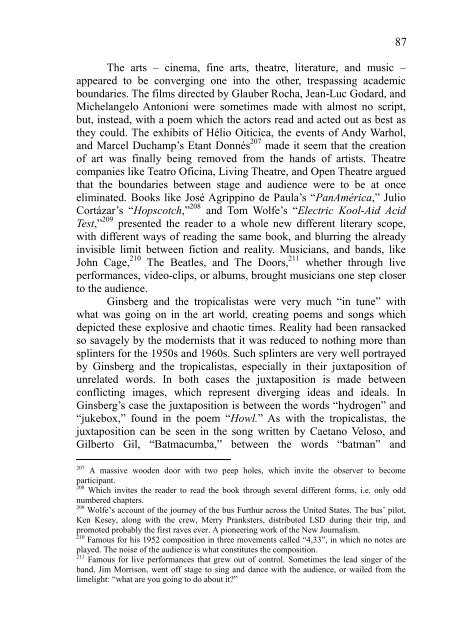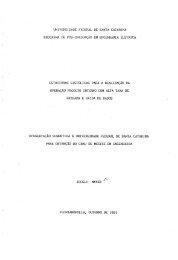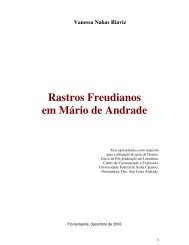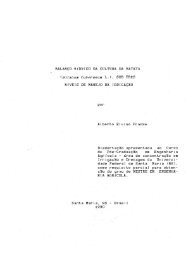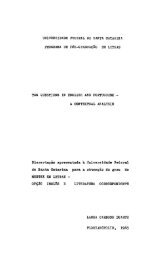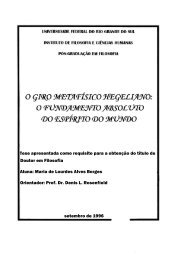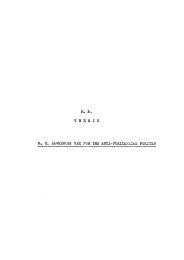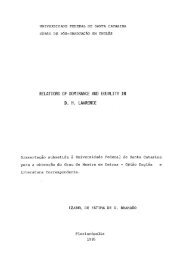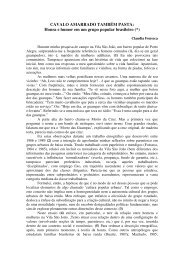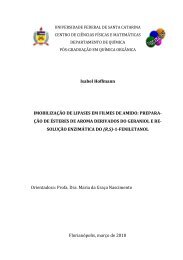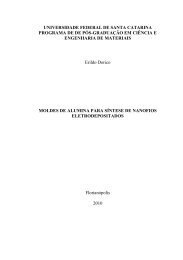Tropical ginsberg
Tropical ginsberg
Tropical ginsberg
Create successful ePaper yourself
Turn your PDF publications into a flip-book with our unique Google optimized e-Paper software.
The arts – cinema, fine arts, theatre, literature, and music –<br />
appeared to be converging one into the other, trespassing academic<br />
boundaries. The films directed by Glauber Rocha, Jean-Luc Godard, and<br />
Michelangelo Antonioni were sometimes made with almost no script,<br />
but, instead, with a poem which the actors read and acted out as best as<br />
they could. The exhibits of Hélio Oiticica, the events of Andy Warhol,<br />
and Marcel Duchamp’s Etant Donnés 207 made it seem that the creation<br />
of art was finally being removed from the hands of artists. Theatre<br />
companies like Teatro Oficina, Living Theatre, and Open Theatre argued<br />
that the boundaries between stage and audience were to be at once<br />
eliminated. Books like José Agrippino de Paula’s “PanAmérica,” Julio<br />
Cortázar’s “Hopscotch,” 208 and Tom Wolfe’s “Electric Kool-Aid Acid<br />
Test,” 209 presented the reader to a whole new different literary scope,<br />
with different ways of reading the same book, and blurring the already<br />
invisible limit between fiction and reality. Musicians, and bands, like<br />
John Cage, 210 The Beatles, and The Doors, 211 whether through live<br />
performances, video-clips, or albums, brought musicians one step closer<br />
to the audience.<br />
Ginsberg and the tropicalistas were very much “in tune” with<br />
what was going on in the art world, creating poems and songs which<br />
depicted these explosive and chaotic times. Reality had been ransacked<br />
so savagely by the modernists that it was reduced to nothing more than<br />
splinters for the 1950s and 1960s. Such splinters are very well portrayed<br />
by Ginsberg and the tropicalistas, especially in their juxtaposition of<br />
unrelated words. In both cases the juxtaposition is made between<br />
conflicting images, which represent diverging ideas and ideals. In<br />
Ginsberg’s case the juxtaposition is between the words “hydrogen” and<br />
“jukebox,” found in the poem “Howl.” As with the tropicalistas, the<br />
juxtaposition can be seen in the song written by Caetano Veloso, and<br />
Gilberto Gil, “Batmacumba,” between the words “batman” and<br />
207<br />
A massive wooden door with two peep holes, which invite the observer to become<br />
participant.<br />
208<br />
Which invites the reader to read the book through several different forms, i.e. only odd<br />
numbered chapters.<br />
209<br />
Wolfe’s account of the journey of the bus Furthur across the United States. The bus’ pilot,<br />
Ken Kesey, along with the crew, Merry Pranksters, distributed LSD during their trip, and<br />
promoted probably the first raves ever. A pioneering work of the New Journalism.<br />
210<br />
Famous for his 1952 composition in three movements called “4,33”, in which no notes are<br />
played. The noise of the audience is what constitutes the composition.<br />
211<br />
Famous for live performances that grew out of control. Sometimes the lead singer of the<br />
band, Jim Morrison, went off stage to sing and dance with the audience, or wailed from the<br />
limelight: “what are you going to do about it?”<br />
87


